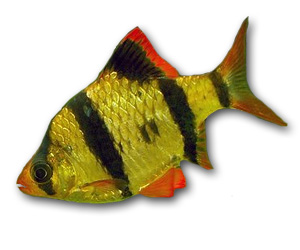Tiger Barb

Quick Stats
| Size | Up to 3" (7cm) |
|---|---|
| Tank | 60 litres for a small school |
| Swimming Area | Bottom, middle |
| Ph | 6.5 to 7.5 |
| Temperature | 68ºF to 78ºF (20-26°C) |
| Food | Flakes and frozen foods as well as live. |
Common Name:
Tiger Barb, Sumatra Barb.
Distribution:
Borneo and Sumatra, also reported in Thailand.
Colouration:
There are many different variations of the Tiger Barb available today. They range from the Albino to the Green, I will describe the "original" and in my opinion the prettiest, here. Counting the eye stripe there are four wide Black-Blue bands running across the body The third band starts at the Black base of the Dorsal fin and extends down to the start of the Anal fin. The Dorsal and Anal fins are a bright Red-Orange and the rest of the fins are a paler shade of Red. The rest of the body is a Brown-Orange color and the Back is almost like an Olive Green. The scales viewed under the right light have an iridescent Gold or Brass look to them.
Lifespan:
Up to 6 years.
Maintenance:
10 to 20% weekly water change. The only drawback to these fish is their tendency to nip the fins of fish in the tank, especially angels. Single specimens tend to be aggressive and should not be kept. Tiger Barbs should be kept in a school of at least six fish.
Feeding:
Feeding is not a problem as they will accept all types of food including flake and frozen, don't overfeed as they are ravenous eaters and will eat all you give them.
Substrate:
Sandy material.
Tank Decor:
The tank should be sparsely planted with plenty of open space for swimming with a sandy bottom for digging.
Filtration:
Standard filtration for the size of tank.
Biotype:
Bottom areas of slow moving and calm waters on Sumatra and its' other locals.
Breeding:
Male tiger Barbs are slimmer and more colorful than the females. They breed similar to other Barb species. The breeding tank should have a thin layer or no substrate and a few leafy plants and be as large as possible. Condition the spawners with the best food possible for a few days before transferring them to the breeding tank. They usually will spawn in the morning after being introduced to the tank, a partial water change can also induce spawning. The female is the more active partner and will lead in the courtship. After chasing and false matings the pair will spawn in the plants, with the partners coming alongside each other and the male twisting around the female. The eggs are scattered among the plants and they can be quite large in number. Tigers, like most Barbs are spawn eaters and should be removed from the tank right after mating. The transparent eggs will hatch in about 24 hours at a temperature of 75º and the small young must be fed the finest of food like Brine shrimp Nauplii, once a little growth has taken place they are fairly easy to raise.